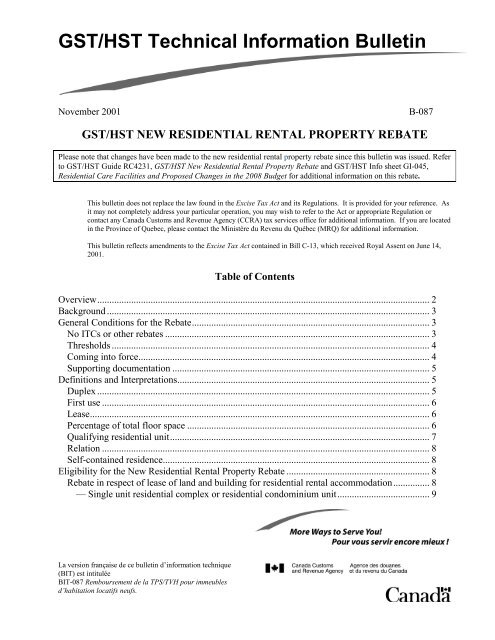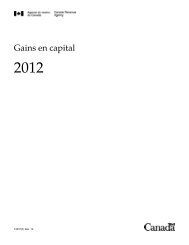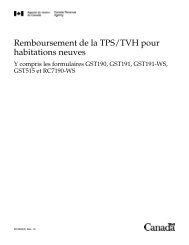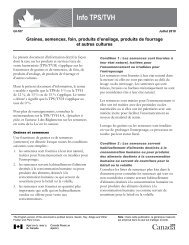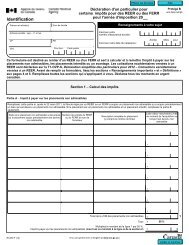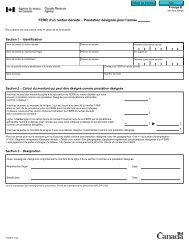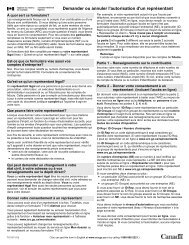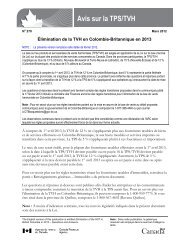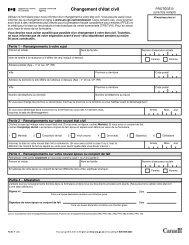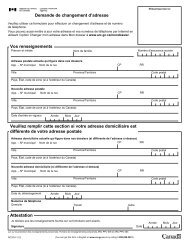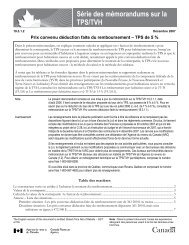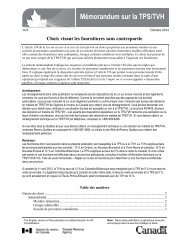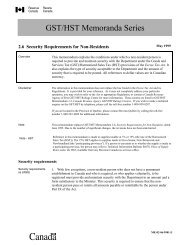GST/HST New Residential Rental Property Rebate - Agence du ...
GST/HST New Residential Rental Property Rebate - Agence du ...
GST/HST New Residential Rental Property Rebate - Agence du ...
Create successful ePaper yourself
Turn your PDF publications into a flip-book with our unique Google optimized e-Paper software.
<strong>GST</strong>/<strong>HST</strong> Technical Information Bulletin<br />
November 2001 B-087<br />
<strong>GST</strong>/<strong>HST</strong> NEW RESIDENTIAL RENTAL PROPERTY REBATE<br />
Please note that changes have been made to the new residential rental property rebate since this bulletin was issued. Refer<br />
to <strong>GST</strong>/<strong>HST</strong> Guide RC4231, <strong>GST</strong>/<strong>HST</strong> <strong>New</strong> <strong>Residential</strong> <strong>Rental</strong> <strong>Property</strong> <strong>Rebate</strong> and <strong>GST</strong>/<strong>HST</strong> Info sheet GI-045,<br />
<strong>Residential</strong> Care Facilities and Proposed Changes in the 2008 Budget for additional information on this rebate.<br />
This bulletin does not replace the law found in the Excise Tax Act and its Regulations. It is provided for your reference. As<br />
it may not completely address your particular operation, you may wish to refer to the Act or appropriate Regulation or<br />
contact any Canada Customs and Revenue Agency (CCRA) tax services office for additional information. If you are located<br />
in the Province of Quebec, please contact the Ministère <strong>du</strong> Revenu <strong>du</strong> Québec (MRQ) for additional information.<br />
This bulletin reflects amendments to the Excise Tax Act contained in Bill C-13, which received Royal Assent on June 14,<br />
2001.<br />
La version française de ce bulletin d’information technique<br />
(BIT) est intitulée<br />
BIT-087 Remboursement de la TPS/TVH pour immeubles<br />
d’habitation locatifs neufs.<br />
Table of Contents<br />
Overview ......................................................................................................................................... 2<br />
Background ..................................................................................................................................... 3<br />
General Conditions for the <strong>Rebate</strong> .................................................................................................. 3<br />
No ITCs or other rebates ............................................................................................................. 3<br />
Thresholds ................................................................................................................................... 4<br />
Coming into force ........................................................................................................................ 4<br />
Supporting documentation .......................................................................................................... 5<br />
Definitions and Interpretations ........................................................................................................ 5<br />
Duplex ......................................................................................................................................... 5<br />
First use ....................................................................................................................................... 6<br />
Lease ............................................................................................................................................ 6<br />
Percentage of total floor space .................................................................................................... 6<br />
Qualifying residential unit ........................................................................................................... 7<br />
Relation ....................................................................................................................................... 8<br />
Self-contained residence.............................................................................................................. 8<br />
Eligibility for the <strong>New</strong> <strong>Residential</strong> <strong>Rental</strong> <strong>Property</strong> <strong>Rebate</strong> ........................................................... 8<br />
<strong>Rebate</strong> in respect of lease of land and building for residential rental accommodation ............... 8<br />
— Single unit residential complex or residential condominium unit ...................................... 9
- 2 -<br />
— Multiple unit residential complex or an addition to one ..................................................... 9<br />
<strong>Rebate</strong> in respect of sale of building and lease of land ............................................................. 11<br />
— Single unit residential complex or residential condominium unit .................................... 12<br />
— Multiple unit residential complex or an addition to one ................................................... 14<br />
<strong>Rebate</strong> for cooperative housing corporation ............................................................................. 15<br />
— Single unit residential complex ........................................................................................ 15<br />
— Multiple unit residential complex or an addition to one ................................................... 16<br />
<strong>Rebate</strong> for land leased for residential purposes ......................................................................... 17<br />
— Lease of land, other than land in a residential trailer park ................................................ 17<br />
— Lease of land in a residential trailer park .......................................................................... 19<br />
Temporary <strong>Rental</strong>s Before Sale .................................................................................................... 21<br />
Applying for the <strong>Residential</strong> <strong>Rental</strong> <strong>Property</strong> <strong>Rebate</strong> ................................................................... 21<br />
Time limits ................................................................................................................................ 22<br />
Appendix: Qualifying portion of basic tax content ................................................................... A - 1<br />
Overview<br />
Amendments to the Excise Tax Act (the Act) that created a new rebate for persons who supply new<br />
residential rental properties received Royal Assent on June 14, 2001. The new residential rental<br />
property rebate contained in section 256.2 of the Act is now available under particular conditions to:<br />
• persons that supply residential properties by way of lease, licence or similar arrangement. In<br />
general, the properties must be newly constructed or substantially renovated or converted<br />
residential rental properties and they must be intended for long-term residential accommodation.<br />
• persons who sell the building portion of a residential complex and who supply the land portion<br />
by way of lease, licence or similar arrangement for a period of at least twenty years or the lease<br />
contains an option to purchase the land.<br />
• persons who supply qualifying residential units in an addition to multiple unit residential rental<br />
properties.<br />
• cooperative housing corporations in respect of new qualifying residential units. However, for<br />
units supplied to indivi<strong>du</strong>als who acquire shares in the corporation that give the purchaser a right<br />
to occupy a new residential unit of the corporation, the new rental rebate that the cooperative<br />
receives is re<strong>du</strong>ced by the amount of the new housing rebate to which the purchaser is entitled.<br />
• persons who supply land by way of lease, licence or similar arrangement for long-term residential<br />
use; and<br />
• persons who supply sites in residential trailer parks by way of lease, licence or similar<br />
arrangement for long-term residential use.<br />
The new residential rental property rebate will also be available where a new residential unit that is<br />
for sale is first leased, but special rules will apply.<br />
The maximum rebate is 36% of the <strong>GST</strong> or federal portion of the <strong>HST</strong> paid or deemed paid by the<br />
person on the acquisition, or deemed acquisition, of qualifying residential rental properties. The<br />
rebate does not apply, however, to the provincial portion of the <strong>HST</strong>. The maximum rebate amount<br />
for each qualifying residential rental property is $8,750.
- 3 -<br />
The new residential rental property rebate applies to construction, substantial renovations or<br />
conversions that were started after February 27, 2000, and to lease agreements signed after that date.<br />
Background<br />
A person who buys a newly constructed residential rental property, e.g., an apartment building, from<br />
a builder, is liable for <strong>GST</strong>/<strong>HST</strong> calculated on the sale price of the property. If the purchaser then<br />
supplies the units in the new residential rental property to indivi<strong>du</strong>als as a place of residence under<br />
long-term leases, the supply of the units is generally exempt and input tax credits (ITCs) are not<br />
available to the purchaser (now landlord) in respect of the <strong>GST</strong>/<strong>HST</strong> paid upon acquiring the<br />
property. As a result, the purchaser/landlord finances the tax liability up front and recovers the tax<br />
over time.<br />
Similarly, if a builder constructs a new residential rental property, e.g., an apartment building, and<br />
supplies the units in the new residential rental property by way of lease, licence or similar<br />
arrangement, the builder is required to self-assess tax on the fair market value of the entire property<br />
when the first unit is first rented. If the builder leases the units in the new residential rental property<br />
to indivi<strong>du</strong>als as a place of residence under long-term leases, the builder/landlord is in the same<br />
position as the purchaser/landlord in that the supply of the units is exempt and ITCs are not available<br />
in respect of the <strong>GST</strong>/<strong>HST</strong> paid at the time of self-supply. Thus, while the <strong>GST</strong>/<strong>HST</strong> would be<br />
financed up front, its recovery would occur over time.<br />
This inability to recover <strong>GST</strong>/<strong>HST</strong> except over time is experienced by persons who supply land by<br />
way of lease for long-term residential use, by persons who supply sites by way of lease for long-term<br />
residential use in residential trailer parks, and by cooperative housing corporations.<br />
While existing <strong>GST</strong>/<strong>HST</strong> new housing rebates allow the recovery of a portion of the <strong>GST</strong>/<strong>HST</strong> paid<br />
or payable by the purchaser when new housing is acquired, they do not apply to new rental<br />
properties. The new residential rental property rebate now allows a recovery of a portion of the<br />
<strong>GST</strong>/<strong>HST</strong> paid or payable in respect of residential rental properties.<br />
General Conditions for the <strong>Rebate</strong><br />
No ITCs or other rebates<br />
A person who is entitled to claim ITCs in respect of any part of the tax payable on the acquisition of<br />
the property or the tax self-assessed under section 191 1 is not entitled to the new rental rebate. The<br />
same is true for a person entitled to claim other rebates in respect of the property such as a public<br />
service body (PSB) rebate or a new housing rebate. No amount of tax can be included in the rebate<br />
to the extent that the person is, under any other Act or law, not required to pay or remit or is entitled<br />
to recover by way of rebate, refund or remission.<br />
1 See the section “<strong>Rebate</strong> in respect of lease of land and building for residential rental accommodation” in this bulletin.<br />
For a complete discussion of the self-assessment provisions of section 191, see <strong>GST</strong>/<strong>HST</strong> Memoran<strong>du</strong>m 19.2.3,<br />
<strong>Residential</strong> Real <strong>Property</strong>—Deemed Supplies.
- 4 -<br />
Thresholds<br />
The thresholds for the new residential rental property rebate apply on a unit-by-unit basis, except in<br />
the case of <strong>du</strong>plexes where the thresholds apply to the value of the entire complex, i.e., both units.<br />
The full rebate is available for qualifying residential units whose value does not exceed $350,000.<br />
For rental units valued between $350,000 and $450,000, the rebate is gra<strong>du</strong>ally re<strong>du</strong>ced. No rebate<br />
is available for rental units valued at $450,000 or more. Except where otherwise noted, these are the<br />
same rebate thresholds that apply for <strong>GST</strong>/<strong>HST</strong> new housing rebates.<br />
A similar rebate range applies in the case of land that is leased for residential purposes. The full<br />
rebate is available where the fair market value of the land (other than a site in a residential trailer<br />
park or in an addition to one) or the fair market value of a site in a residential trailer park or in an<br />
addition to one does not exceed $87,500. For land or a site valued between $87,500 and $112,500,<br />
the rebate is gra<strong>du</strong>ally re<strong>du</strong>ced. No rebate is available for land or a site whose fair market value is<br />
$112,500 or more. The fair market value of a site in a residential trailer park or in an addition to one<br />
is determined by dividing the fair market value of the entire park or addition to the park by the total<br />
number of sites in the park or addition as the case may be.<br />
Coming into force<br />
The new residential rental property rebate applies to construction, substantial renovations,<br />
conversions or additions to rental properties that were started after February 27, 2000. Generally,<br />
construction is considered to begin at the time the excavation work relating to the residential<br />
complex begins. In the case of a deemed substantial renovation of a building converted into a<br />
residential complex, the rebate applies if the construction or alteration necessary to effect the<br />
conversion began after February 27, 2000. In the case of leased land, the rebate applies if the lease<br />
agreement is entered into after February 27, 2000.
Supporting documentation<br />
For rebate applications<br />
concerning:<br />
a single unit residential<br />
complex<br />
- 5 -<br />
Supporting documents to be included with the rebate<br />
application:<br />
(photocopies acceptable)<br />
• statement of adjustments;<br />
• the purchase agreement (only for claimants who have purchased<br />
the single unit residential complex);<br />
• the lease/rental agreement; or<br />
• the insurance policy (that the claimant has on the property, not<br />
the lessee insurance policy);<br />
whichever is appropriate for the claimant’s particular rebate<br />
application.<br />
a lease of land • the lease/rental agreement; or<br />
• the statement of adjustments.<br />
all other cases No supporting documents need to be submitted with the rebate<br />
application. However, all records must be retained for verification<br />
purposes, including receipts, invoices, written contracts, and<br />
agreements, for six years after the end of the year to which they<br />
relate. The CCRA may ask for these documents to verify the amount<br />
of the rebate claim and the statements certified on the rebate<br />
application form. All claims are subject to verification.<br />
Definitions and Interpretations<br />
Duplex<br />
A <strong>du</strong>plex is a residential complex situated on a single legal land description that contains not more<br />
than two residential units where each unit contains private kitchen facilities, a private bath and a<br />
private living area. For purposes of the new residential rental property rebate, references to a single<br />
unit residential complex include a <strong>du</strong>plex. Therefore, the new residential rental property rebate in<br />
respect of a <strong>du</strong>plex is in accordance with the provisions for a single unit residential complex. The<br />
thresholds and phase out provisions apply to the value of the entire complex, i.e., both units.<br />
Where a residential unit in a <strong>du</strong>plex is supplied by way of lease and at least one of the two residential<br />
units meets the definition of a qualifying residential unit, the new residential rental property rebate<br />
may be available in respect of tax paid for the acquisition of the entire residential complex, i.e., both<br />
units, provided a <strong>GST</strong>/<strong>HST</strong> new housing rebate cannot be claimed in respect of the complex. The<br />
$350,000 threshold at which the rebate starts to decrease is the same threshold as for a single unit<br />
residential complex. The threshold does not apply to each unit separately. It applies to the fair<br />
market value of the entire complex, i.e., both units.
- 6 -<br />
In some situations, there may be uncertainty about the number of separate residential units in a<br />
building. To determine how many separate residential units there are, one must apply the test of<br />
“direct internal access”. Under this test, if a residential unit (referred to for purposes of this<br />
explanation as the “specified unit”) in a building affords direct internal access (with or without the<br />
use of a key or similar device) to another area of the building that is all or part of the living area of a<br />
particular residential unit, the specified unit is deemed to be part of the particular residential unit and<br />
not a separate residential unit.<br />
Example: A newly constructed building, situated on a single legal land description, is composed<br />
of two two-storey, semi-detached units. One of the two-storey units is further divided into an<br />
upstairs unit and a downstairs unit.<br />
The occupants of the upstairs unit must pass through the kitchen area of the downstairs unit to reach<br />
the stairs leading to their unit. In this situation, the upstairs unit is deemed to be part of the<br />
downstairs unit. They are not separate units for purposes of the new residential rental property<br />
rebate. Thus, this building is a <strong>du</strong>plex and the rebate formula and threshold levels that are<br />
appropriate for a <strong>du</strong>plex apply here. The building is not considered to be a multiple unit residential<br />
complex containing three units.<br />
First use<br />
“First use” in respect of a new residential unit (other than a residential unit in a multiple unit<br />
residential complex) means the first use of the unit after the construction or substantial renovation of<br />
the unit is substantially completed. In the case of a residential unit situated in a multiple unit<br />
residential complex, “first use” means the first use of the unit after the construction or last substantial<br />
renovation of the complex, or addition to the complex, in which the unit is situated is substantially<br />
completed.<br />
Lease<br />
A reference to a lease may be read as a reference to a “lease, licence or similar arrangement”.<br />
Percentage of total floor space<br />
The percentage of total floor space in respect of a residential unit that forms part of a residential<br />
complex or part of an addition to a multiple unit residential complex means the percentage that the<br />
total square metres of floor space occupied by the unit is of the total square metres of floor space<br />
occupied by all the residential units in the complex or addition as the case may be.
- 7 -<br />
Qualifying residential unit<br />
The definition of “qualifying residential unit” is key to targetting the rebate to new rental properties<br />
supplied for long-term use by indivi<strong>du</strong>als as a primary place of residence. In doing so, the definition<br />
sets out various criteria for the person holding the residential unit to qualify for a rebate under<br />
section 256.2. The criteria address: the nature of the unit itself, the purpose for which person<br />
supplies the unit, the nature of its occupancy, and the <strong>du</strong>ration of the first occupancy. Specifically, a<br />
residential unit is a qualifying residential unit of a person at a particular time if:<br />
• the person is<br />
— the owner or a co-owner, a lessee or a sublessee of the unit or has possession of the unit as<br />
purchaser under an agreement of purchase and sale; or<br />
— a lessee or a sublessee of a residential complex in which the residential unit is situated;<br />
• the residential unit is a self-contained residence;<br />
• the residential unit is held by the person<br />
— for the purpose of making exempt supplies included in section 5.1, 6, 6.1 or 7 of Part I of<br />
sche<strong>du</strong>le V to the Act 2 ; or<br />
— if the unit is held for use as the primary place of residence of the person, the complex in<br />
which the unit is situated includes one or more other residential units at least one of which is<br />
a qualifying residential unit of the person;<br />
• the unit will be first used or it can reasonably be expected by the person that the first use of the<br />
unit will be as the primary place of residence of indivi<strong>du</strong>als, which could include the person or a<br />
relation of the person;<br />
• the use as a primary place of residence by each such indivi<strong>du</strong>al<br />
— must be for a period of at least one year, although not necessarily under one lease (e.g., an<br />
indivi<strong>du</strong>al could occupy a unit for one year under twelve consecutive monthly leases); or<br />
— if the period is less than one year, the residential unit could still be a qualifying residential<br />
unit provided the unit:<br />
(i) is sold to a recipient who acquires the unit for use as the primary place of residence of<br />
the recipient or a relation,<br />
(ii) is taken for use as the primary place of residence of the person or a relation, or<br />
(iii) is taken as the primary place of residence of a lessor of the complex or a relation of<br />
that lessor.<br />
Finally, if the person intends that once the unit has been occupied as a primary place of residence of<br />
an indivi<strong>du</strong>al for a period of at least one year, the person will occupy the unit or lease it as a place of<br />
residence or lodging to an indivi<strong>du</strong>al who is a relation, shareholder, member or partner of the person,<br />
or with whom the person is not dealing at arm’s length, then the unit must be used as the primary<br />
place of residence of the person or that indivi<strong>du</strong>al.<br />
In general, the occupancy requirements set out in the definition of qualifying residential unit are<br />
applied on a unit-by-unit basis. In the case of large multiple unit residential complexes, i.e., 10 or<br />
more residential units, the entire complex is considered to meet the expected one-year occupancy test<br />
if substantially all of the units (90% or more) meet that test.<br />
2<br />
These sections of Part I of Sche<strong>du</strong>le V are explained later in this bulletin in the section “Eligibility for the <strong>New</strong><br />
<strong>Residential</strong> <strong>Rental</strong> <strong>Property</strong> <strong>Rebate</strong>”.
- 8 -<br />
Relation<br />
“Relation” of a particular indivi<strong>du</strong>al means another indivi<strong>du</strong>al who is related to the particular<br />
indivi<strong>du</strong>al or who is a former spouse or former common-law partner of the particular indivi<strong>du</strong>al.<br />
This is the same meaning as is found in subsection 256(1) of the Act.<br />
Self-contained residence<br />
A self-contained residence means a residential unit that<br />
• is a suite or room in a hotel, a motel, an inn, a boarding house or a lodging house or in a<br />
residence for students, seniors, indivi<strong>du</strong>als with a disability or other indivi<strong>du</strong>als; or<br />
• contains private kitchen facilities, a private bath and a private living area.<br />
Eligibility for the <strong>New</strong> <strong>Residential</strong> <strong>Rental</strong> <strong>Property</strong> <strong>Rebate</strong><br />
The provisions of section 256.2 set out the rebate for four categories of new residential rental<br />
properties:<br />
• rebate in respect of lease of land and building for residential rental accommodation;<br />
• rebate in respect of sale of building and lease of land;<br />
• rebate for cooperative housing corporation; and<br />
• rebate for land leased for residential purposes.<br />
Each category is discussed below.<br />
<strong>Rebate</strong> in respect of lease of land and building for residential rental accommodation<br />
A person is eligible to claim a new residential rental property rebate in respect of land and building<br />
if:<br />
• the person has bought and paid tax on a residential complex (which includes a <strong>du</strong>plex as defined<br />
above), or an interest in such, and is not a builder of the complex,<br />
or<br />
• the person is a builder of a residential complex or of an addition to a multiple unit residential<br />
complex who has self-assessed tax as required under section 191 upon leasing the first unit in the<br />
residential complex under exempt conditions in section 6 3 or 6.1 4 of Part I of Sche<strong>du</strong>le V to the<br />
Act (see below);<br />
3 Section 6 of Part I of Sche<strong>du</strong>le V exempts long-term supplies of a residential complex or a residential unit in a<br />
residential complex by way of lease, licence or similar arrangement if the complex or unit is to be occupied as a place of<br />
residence or lodging by an indivi<strong>du</strong>al. Section 6 also exempts the supply of a residential unit by way of lease or licence<br />
where the consideration does not exceed $20 per day. For a long-term lease of a residential complex or unit to be<br />
exempt, it must be occupied by the same indivi<strong>du</strong>al for a continuous period of at least one month. The person who has<br />
paid tax on the last acquisition of such residential rental accommodation and who supplies it on an exempt basis under<br />
section 6 of Part I of Sche<strong>du</strong>le V may be eligible to claim the new residential rental property rebate in respect of the<br />
property.
- 9 -<br />
and<br />
• the person is not a cooperative housing corporation;<br />
• the property is a qualifying residential unit of the person or includes one or more qualifying<br />
residential units of the person; and<br />
• the person is not entitled to include the tax in respect of the purchase from the supplier or the<br />
self-assessed tax in the case of a builder when determining ITCs.<br />
— Single unit residential complex or residential condominium unit<br />
If the complex is a single unit residential complex (including a <strong>du</strong>plex) or a residential condominium<br />
unit with a fair market value of $350,000 or less, the new residential rental property rebate is the<br />
lesser of $8,750 and 36% of the <strong>GST</strong> or the federal portion of the <strong>HST</strong>, i.e., 7/15 of the <strong>HST</strong>, paid on<br />
the actual or deemed purchase of the residential complex.<br />
If the complex has a fair market value exceeding $350,000, the rebate is determined by the formula:<br />
where<br />
A × ($450,000 – B)/$100,000<br />
A is the lesser of<br />
(i) $8,750, and<br />
(ii) 36% of the <strong>GST</strong> or the federal portion of the <strong>HST</strong>, i.e., 7/15 of the <strong>HST</strong>, in respect of the<br />
actual or deemed purchase,<br />
and<br />
B is the greater of<br />
(i) $350,000 and<br />
(ii) the fair market value of the single unit residential complex or residential condominium unit<br />
at the time tax is payable.<br />
— Multiple unit residential complex or an addition to one<br />
If the complex is a multiple unit residential complex (i.e., a residential complex that contains more<br />
than two residential units) or an addition to one, the amount to be rebated in respect of each<br />
qualifying residential unit in the complex is calculated as:<br />
where<br />
A × ($450,000 – B)/$100,000<br />
4 Section 6.1 of Part I of Sche<strong>du</strong>le V exempts supplies of land, residential buildings, or a residential complex by way of<br />
lease, licence or similar arrangement to a person who, in turn, supplies the property by way of lease, licence or similar<br />
arrangement on an exempt basis under section 6 or 7 of Part I, or to a lessee or sublessee described in section 6.1. The<br />
person who has paid tax on the last acquisition of the property and who supplies it on an exempt basis under section 6.1<br />
of Part I of Sche<strong>du</strong>le V may be eligible to claim the new residential rental property rebate.
- 10 -<br />
A is the lesser of $8,750 and the amount determined by the formula<br />
A1 × A2<br />
where<br />
A1 is 36% of the <strong>GST</strong> or the federal portion of the <strong>HST</strong>, i.e., 7/15 of the <strong>HST</strong>, that is payable in<br />
respect of the purchase from the supplier or is deemed to have been paid in respect of the deemed<br />
purchase, and<br />
A2 is the unit’s percentage of total floor space,<br />
and<br />
B is the greater of $350,000 and the amount determined by the formula<br />
B1 × B2<br />
where<br />
B1 is the unit’s percentage of total floor space, and<br />
B2 is the fair market value of the entire complex or addition at the time tax is payable.<br />
The new residential rental property rebate payable in respect of the complex is equal to the sum of<br />
the amounts for each qualifying residential unit in the complex. Apportioning the complex’s fair<br />
market value is done in the formula by comparing the percentage of total floor space of a particular<br />
unit to the total floor space for all of the units in the property (B1) and multiplying that amount by the<br />
fair market value of the whole complex or the addition (B2).<br />
An applicant will make only one rebate claim for a multiple-unit residential complex or addition.<br />
This means that there will be one rebate payment that will be the sum of all rebate amounts for each<br />
qualifying residential unit in the complex or addition.<br />
Example<br />
Rentco Inc., a BC firm, constructs a 100-unit apartment building with a fair market value of<br />
$3,000,000. Each unit in the building is a self-contained residence, that is, each unit has private<br />
kitchen facilities, a private bath and a private living area. The company intends to supply each<br />
apartment under a long-term lease as a primary place of residence for indivi<strong>du</strong>als. All units have the<br />
same amount of floor space. Following substantial completion of the building, Rentco gives<br />
possession of the first apartment to an indivi<strong>du</strong>al under a one-year lease. The terms of the lease<br />
permit the tenant to use the apartment only as a place of residence. When Rentco supplies<br />
possession of the first apartment, Rentco is deemed under the provisions of subsection 191(3) of the<br />
Act to have sold and repurchased and paid tax calculated on the fair market value of the entire<br />
multiple unit residential complex, i.e., 7% × $3,000,000 = $210,000. In this situation, Rentco is<br />
eligible to claim a new residential rental property rebate.<br />
<strong>Rebate</strong> calculation:<br />
where<br />
A × ($450,000 – B)/$100,000<br />
A is the lesser of $8,750 and the amount determined by the formula
- 11 -<br />
A1 × A2<br />
where<br />
A 1 = 36% of the <strong>GST</strong> that is deemed to have been paid in respect of the deemed purchase,<br />
= 36% × $210,000<br />
= $75,600<br />
and<br />
A 2 = the unit’s percentage of total floor space<br />
= 1% (since there are 100 units of the same size).<br />
Since A is the lesser of $8,750 and ($75,600 × 1% = $756)<br />
A = $756;<br />
and<br />
B is the greater of $350,000 and the amount determined by the formula<br />
B 1 × B 2<br />
where<br />
B 1 = the unit’s percentage of total floor space,<br />
= 1%<br />
and<br />
B 2 = the fair market value at the time tax is payable,<br />
= $3,000,000.<br />
Since B 1 × B 2 = (1% x $3,000,000) = $30,000,<br />
B = $350,000.<br />
Accordingly, the new residential rental property rebate for each of Rentco’s units:<br />
= A × ($450,000 – B)/$100,000<br />
= $756 × ($450,000 – $350,000)/$100,000<br />
= $756.<br />
The total new residential rental property rebate for Rentco’s multiple unit residential complex is<br />
$756 × 100 (i.e., the number of qualifying units in the complex) = $75,600.<br />
<strong>Rebate</strong> in respect of sale of building and lease of land<br />
A person is eligible to claim a new residential rental property rebate if a building that forms part of a<br />
residential complex is sold and the related land is supplied to the purchaser of the building by way of<br />
lease. The supplier of the land and building is eligible to claim a new residential rental property<br />
rebate if:<br />
• the person is a builder of a residential complex or an addition to a multiple unit residential<br />
complex;<br />
• the builder is not a cooperative housing corporation;
- 12 -<br />
• the person makes an exempt supply by way of sale included in section 5.1 of Part I of Sche<strong>du</strong>le V<br />
of a building or part of a building, and an exempt supply of land by way of lease, or assignment<br />
of lease, included in section 7 of that Part 5 ;<br />
• the lease provides for continuous possession or use of the land for a period of at least twenty<br />
years or it contains an option to purchase the land;<br />
• the person who supplies the residential complex is deemed under section 191 to have made and<br />
received a taxable supply by way of sale of the complex or addition and to have paid tax at a<br />
particular time in respect of that supply;<br />
• in the case of a multiple unit residential complex or an addition to such a complex, the complex<br />
or addition, as the case may be, includes, at the particular time, one or more qualifying residential<br />
units of the person;<br />
• the person is not entitled to include the tax payable in respect of the deemed purchase made<br />
under section 191 when determining ITCs of the person; and<br />
• in the case of an exempt supply by way of sale of a single unit residential complex or a<br />
residential condominium unit, the recipient of that supply is entitled to claim a new housing<br />
rebate in respect of the complex or unit.<br />
— Single unit residential complex or residential condominium unit<br />
If the building that is sold forms part of a single unit residential complex or residential condominium<br />
unit and if the residential complex or unit (land and building) has a fair market value of $350,000 or<br />
less, the person calculates the new residential rental property rebate for the land portion of the<br />
residential complex as<br />
A – C<br />
where<br />
A is the lesser of<br />
(i) $8,750 and<br />
(ii) 36% of the <strong>GST</strong> or the federal portion of the <strong>HST</strong>, i.e., 7/15 of the <strong>HST</strong>, that is deemed to<br />
have been paid in respect of the deemed purchase of the residential complex (i.e., land and<br />
building);<br />
and<br />
C is the amount of the new housing rebate under subsection 254.1(2) that the purchaser of the<br />
building is entitled to claim in respect of the complex or unit.<br />
5 Section 5.1 of Part I of Sche<strong>du</strong>le V exempts the sale of a building that contains one or more residential units where the<br />
building is sold to the lessee of the land on which the building is situated. In order to qualify for the exemption, the<br />
building must be situated on the land both immediately before and immediately after it is sold and the lease of the land<br />
must be exempt by virtue of subparagraph 7(a)(i) of Part I of Sche<strong>du</strong>le V, i.e., the recipient of the land supplied by way<br />
of lease is the owner, lessee or person in occupation or possession of a residential unit that is or is to be affixed to the<br />
land for the purpose of its use and enjoyment as a place of residence for indivi<strong>du</strong>als. A builder who has made an exempt<br />
sale under section 5.1 of Part I of Sche<strong>du</strong>le V and an exempt lease under subparagraph 7(a)(i) of the same Part may be<br />
eligible to claim the new residential rental property rebate in respect of the tax owing on the deemed self-supply made<br />
under section 191.
- 13 -<br />
The rebate referred to in element C of this formula is the new housing rebate available to purchasers<br />
of a residential complex where the building is purchased and the land is leased 6 .<br />
Thus, there could be two rebates available in situations where a building forming part of a residential<br />
complex is sold and the land forming part of that residential complex is leased:<br />
• the existing new housing rebate under section 254.1 is available to the purchaser of the building,<br />
and<br />
• the new residential rental property rebate under section 256.2 is available to the owner/lessor of<br />
the land.<br />
However, if the purchaser of the building is not entitled to claim a new housing rebate, the new<br />
residential rental property rebate will not be available in respect of the property either.<br />
If the fair market value of the residential complex (land and building) exceeds $350,000, and if the<br />
conditions for the rebate are satisfied, the person calculates the new residential rental property rebate<br />
for the land portion of the residential complex by using the following formula:<br />
where<br />
[A × ($450,000 – B)/$100,000] – C<br />
A is the lesser of<br />
(i) $8,750 and<br />
(ii) 36% of the <strong>GST</strong> or the federal portion of the <strong>HST</strong>, i.e., 7/15 of the <strong>HST</strong>, that is deemed to<br />
have been paid on the deemed purchase of the residential complex (i.e., land and building);<br />
B is the greater of<br />
(i) $350,000, and<br />
(ii) the fair market value of the single unit residential complex or residential condominium unit<br />
at the time the tax is deemed payable;<br />
and<br />
C is the amount of the rebate under subsection 254.1(2) that the purchaser of the building is entitled<br />
to.<br />
Example<br />
Develco, an Ontario firm, developed a parcel of land into serviced lots for residential use. Develco<br />
entered into a contract with Buildco whereby Buildco would acquire the lots by way of lease,<br />
construct detached houses on each of the lots and enter into agreements to supply the house by way<br />
of sale to indivi<strong>du</strong>als and the related lot by way of sub-lease.<br />
Due to financing limitations and cash flow requirements, Buildco decided to construct the houses<br />
one at a time. Buildco gave possession of the first completed residential complex and triggered the<br />
requirement to self-assess tax under the self-supply provisions of subparagraph 191(1)(b)(ii). The<br />
6<br />
For more information on this new housing rebate, see <strong>GST</strong>/<strong>HST</strong> Memoran<strong>du</strong>m 19.3.2, <strong>Rebate</strong> for Builder-Built Unit<br />
(Land Leased).
- 14 -<br />
term of the lease was 49 years. There was no option to purchase the land. The deemed tax paid was<br />
$14,000 on a fair market value of the complex of $200,000. The fair market value attributed to the<br />
land lease was $50,000. The purchaser of the building was entitled to claim a new housing rebate in<br />
respect of the <strong>GST</strong>/<strong>HST</strong> for the purchase of the building.<br />
The rebate calculation would be as follows:<br />
where<br />
A – C<br />
A is the lesser of<br />
(i) $8,750 and<br />
(ii) 36% of the <strong>GST</strong> deemed to have been paid in respect of the deemed purchase of the<br />
residential complex (i.e., land and building); in this case, 36% × $14,000 = $5,040;<br />
and<br />
C is the amount of the rebate under subsection 254.1(2) that the purchaser of the residential unit is<br />
entitled to, in this case, ($200,000 – $50,0000) × 2.34% 7 = $3,510.<br />
Therefore, the new residential rental property rebate for the land portion of this residential complex<br />
payable to Buildco is:<br />
A – C = $5,040 – $3,510<br />
= $1,530.<br />
— Multiple unit residential complex or an addition to one<br />
If the building that is sold forms part of a multiple unit residential complex or an addition to one and<br />
the land forming part of the multiple unit residential complex or the addition is leased, the formula to<br />
calculate the amount to be rebated in respect of each qualifying residential unit in the complex is:<br />
where<br />
[A × ($450,000 – B)/$100,000]<br />
A is the lesser of $8,750 and the amount determined by the formula<br />
A1 × A2<br />
where<br />
A1 is 36% of the <strong>GST</strong> or the federal portion of the <strong>HST</strong>, i.e., 7/15 of the <strong>HST</strong>, that the supplier is<br />
deemed to have paid in respect of the deemed purchase of the residential complex (building<br />
and land) at the time tax becomes payable on the supply;<br />
A2 is the unit’s percentage of total floor space,<br />
and<br />
B is the greater of $350,000 and the amount determined by the formula<br />
B1 × B2<br />
7 Subparagraph 254.1(h) provides that where the fair market value of the complex is not more than $374,500, the new<br />
housing rebate amount is equal to the lesser of $8,750 and 2.34% of the total consideration.
- 15 -<br />
where<br />
B1 is the unit’s percentage of total floor space, and<br />
B2 is the fair market value of the residential complex (land and building) or addition, as the case<br />
may be, at the time tax is payable.<br />
The new residential rental property rebate payable in respect of the complex is equal to the sum of<br />
the amounts for each qualifying residential unit in the complex.<br />
<strong>Rebate</strong> for cooperative housing corporation<br />
A cooperative housing corporation is eligible to claim a new residential rental property rebate if:<br />
• the corporation has bought and paid tax on a residential complex or an interest in one and is not<br />
the builder of the complex;<br />
or<br />
• the cooperative is a builder of a residential complex or an addition to a multiple unit residential<br />
complex and makes an exempt supply by way of lease included in section 6 of Part I of Sche<strong>du</strong>le<br />
V 8 that results in the cooperative being deemed under section 191 to have made and received a<br />
taxable supply by way of sale of the complex or addition and to have paid tax in respect of that<br />
supply;<br />
and<br />
• the cooperative is not entitled to include the tax in respect of the purchase from the supplier, or<br />
the tax payable on the deemed purchase under section 191 in the case of a builder, when<br />
determining ITCs; and<br />
• at any time at which a residential unit included in the complex is a qualifying residential unit of<br />
the cooperative, the cooperative first gives occupancy of the unit after its construction or last<br />
substantial renovation under an agreement for a supply of the unit that is an exempt supply<br />
included in section 6 of Part I of Sche<strong>du</strong>le V.<br />
— Single unit residential complex<br />
If the property being supplied is a single unit residential complex with a fair market value of<br />
$350,000 or less, the cooperative calculates the new residential rental property rebate as:<br />
A – C<br />
where<br />
A is the lesser of<br />
(i) $8,750 and<br />
(ii) 36% of the <strong>GST</strong> or the federal portion of the <strong>HST</strong>, i.e., 7/15 of the <strong>HST</strong>, that is deemed to<br />
have been paid in respect of the deemed purchase of the residential complex (i.e., land and<br />
building);<br />
and<br />
8 See footnote #3.
- 16 -<br />
C is the amount of the new housing rebate under subsection 255(2) that the indivi<strong>du</strong>al who is<br />
purchasing a share in the capital stock of the corporation in respect of the unit was entitled to<br />
claim.<br />
If the fair market value of the single unit residential complex exceeds $350,000, the cooperative<br />
calculates the new residential rental property rebate as:<br />
where<br />
[A × ($450,000 – B)/$100,000] – C<br />
A is the lesser of<br />
(i) $8,750 and<br />
(ii) 36% of the <strong>GST</strong> or the federal portion of the <strong>HST</strong>, i.e., 7/15 of the <strong>HST</strong>, that is payable in<br />
respect of the purchase or deemed to have been paid in respect of the deemed purchase of<br />
the residential complex;<br />
B is the greater of<br />
(i) $350,000 and<br />
(ii) the fair market value of the single unit residential complex or residential condominium unit<br />
at the time tax is payable;<br />
and<br />
C is the amount of the new housing rebate under subsection 255(2) that the indivi<strong>du</strong>al who is<br />
purchasing a share in the capital stock of the corporation in respect of the unit was entitled to<br />
claim.<br />
— Multiple unit residential complex or an addition to one<br />
If the unit for which the cooperative is eligible to claim a new residential rental property rebate forms<br />
part of a multiple unit residential complex or an addition to one, the cooperative calculates the new<br />
residential rental property rebate for each unit in the complex as follows:<br />
where<br />
[A × ($450,000 – B)/$100,000] – C<br />
A is the lesser of $8,750 and the amount determined by the formula<br />
A 1 × A 2<br />
where<br />
A 1 is 36% of the <strong>GST</strong> or the federal portion of the <strong>HST</strong>, i.e., 7/15 of the <strong>HST</strong>, that is payable in<br />
respect of the purchase from the supplier or is deemed to have been paid in respect of the<br />
deemed purchase of the residential complex or addition;<br />
A 2 is the unit’s percentage of the total floor space;<br />
B is the greater of $350,000 and the amount determined by the formula<br />
B 1 × B 2
- 17 -<br />
where<br />
B 1 is the unit’s percentage of total floor space, and<br />
B 2 is the fair market value of the multiple unit residential complex or the addition at the time tax<br />
is payable; and<br />
C is the amount of the new housing rebate under subsection 255(2) that the indivi<strong>du</strong>al who is<br />
purchasing a share of the capital stock of the corporation in respect of the unit was entitled to<br />
claim, if any.<br />
<strong>Rebate</strong> for land leased for residential purposes<br />
— Lease of land, other than land in a residential trailer park<br />
If a particular person leases land to another person under conditions that make the supply of the land<br />
an exempt supply under subparagraph 7(a)(i) of Part I of Sche<strong>du</strong>le V, the particular person may be<br />
eligible to claim a new residential rental property rebate. Under subparagraph 7(a)(i) of Part I of<br />
Sche<strong>du</strong>le V, a supply of land (other than a site in a residential trailer park) is exempt if the land is<br />
leased for a period of continuous possession or use of at least one month to the owner, lessee or<br />
person in occupation or possession of a residential unit that is or is to be affixed to the land for the<br />
purpose of its use and enjoyment as a place of residence for indivi<strong>du</strong>als. While the person may lease<br />
any amount of land, the exemption under subparagraph 7(a)(i) applies only to the amount of land<br />
forming part of the residential complex or that will form part of the residential complex when the<br />
residential unit is affixed to it. This amount of land is generally considered to be up to a half<br />
hectare 9 . The new residential rental property rebate applies only in respect of this amount of land.<br />
The person who supplies the land by way of lease may be eligible for the new residential rental<br />
property rebate if in entering the lease agreement, the person is deemed to have made and received a<br />
taxable supply by way of sale of the land and to have paid tax in respect of that deemed supply. In<br />
order to be eligible for the rebate, the deemed sale of the land must occur under subsection 190(3),<br />
200(2), 206(4) or 207(1) of the Act. An overview of these subsections, as they relate to the new<br />
residential rental property rebate, is set out below. Since the supply of the land by way of lease is<br />
exempt, the lessor cannot claim ITCs in respect of this payment of tax on the deemed purchase.<br />
• Subsection 190(3) 10 — Land leased for residential use: If a person supplies land by way of lease<br />
and this is the first supply of the land under an exempt residential lease agreement, i.e., the land<br />
had been used or supplied in ways other than as exempt residential rental accommodation, the<br />
person is required under subsection 190(3) to account for tax on the fair market value of land<br />
when the person gives possession of the land under the lease agreement.<br />
9<br />
For more information on the land allowance for a residential complex, see <strong>GST</strong>/<strong>HST</strong> Memoran<strong>du</strong>m 19.2.1, <strong>Residential</strong><br />
Real <strong>Property</strong>—Sales.<br />
10<br />
For more information on this provision, see <strong>GST</strong>/<strong>HST</strong> Memoran<strong>du</strong>m 19.2.3, <strong>Residential</strong> Real <strong>Property</strong>—Deemed<br />
Supplies.
- 18 -<br />
If a person supplies land by way of lease on an exempt basis under subparagraph 7(a)(i) that<br />
results in the person being deemed to have paid tax under subsection 190(3), and if the<br />
conditions for eligibility for the new residential rental property rebate are otherwise satisfied, the<br />
person would calculate the rebate according to the following formula:<br />
where<br />
A × ($112,500 – B) / $25,000<br />
A is 36% of <strong>GST</strong> or the federal portion of the <strong>HST</strong>, i.e., 7/15 of the <strong>HST</strong>, deemed to have<br />
been paid in respect of the deemed purchase, and<br />
B is the greater of<br />
(i) $87,500 and<br />
(ii) the fair market value of the land forming part of the residential complex (or that will<br />
form part of the complex after the residential unit is affixed to the land) when<br />
possession of the land is given under the lease agreement.<br />
• Subsections 200(2), 206(4) and 207(1) 11 — Change in use: Persons who supply land by way of<br />
lease and whose eligibility for the new residential rental property rebate arises from tax being<br />
deemed paid following a change in use, i.e., under subsections 200(2), 206(4) or 207(1) of the<br />
Act, calculate the rebate by using the following formula:<br />
where<br />
A × ($112,500 – B)/ $25,000<br />
A is 36% of the qualifying portion of the basic tax content (see the Appendix to this<br />
bulletin) at the time possession of the land is given under the lease agreement, and<br />
B is the greater of<br />
(i) $87,500 and<br />
(ii) the fair market value of the land forming part of the residential complex (or that will<br />
form part of it after the residential unit is affixed to the land) when possession of the<br />
land is given under the lease agreement.<br />
• subsection 200(2) — If a registrant that is a public service body (PSB) (other than a financial<br />
institution or a government) ceases to use land that is capital real property primarily in<br />
commercial activities, and begins to use it primarily in non-commercial activities, the PSB is<br />
deemed to have made a supply by way of sale of the land. Specifically, the registrant is deemed<br />
to have sold the land and collected tax on the sale calculated on the basic tax content of the land<br />
11 Further information on the application of subsection 200(2), will be provided in <strong>GST</strong>/<strong>HST</strong> Memoran<strong>du</strong>m 19.6, Real<br />
<strong>Property</strong> and Public Sector Bodies. For further information on the application of subsection 206(4) and subsection<br />
207(1), see the discussion of the change-in-use rules in <strong>GST</strong>/<strong>HST</strong> Memoran<strong>du</strong>m 19.4.2, Commercial Real <strong>Property</strong>—<br />
Deemed Supplies.
- 19 -<br />
at the time of the sale and to have reacquired the land and paid tax equal to the same basic tax<br />
content.<br />
• subsection 206(4) — If a registrant, other than an indivi<strong>du</strong>al or a PSB that is not a financial<br />
institution, ceases to use land that is capital real property in commercial activities and begins to<br />
use it exclusively for other purposes, the registrant is deemed to have made a supply of the land<br />
by way of sale, i.e., the registrant is deemed to have sold the land and collected tax on the sale<br />
calculated on the basic tax content of the land at the time of the sale and to have reacquired the<br />
property and paid tax equal to the same basic tax content.<br />
• subsection 207(1) — If a registrant who is an indivi<strong>du</strong>al ceases to use land that is capital real<br />
property in commercial activities and begins to use it exclusively for other purposes or primarily<br />
for his or her personal use and enjoyment or for the personal use and enjoyment of a related<br />
indivi<strong>du</strong>al, the registrant is deemed to have made a supply of the land by way of sale, i.e., the<br />
registrant is deemed to have sold the land and collected tax on the sale calculated on the basic tax<br />
content of the land at the time of the sale and to have reacquired the property and paid the tax<br />
equal to the same basic tax content.<br />
The term “qualifying portion of basic tax content” is explained in the Appendix to this bulletin,<br />
which also contains a sample calculation. Note that for most persons (i.e., persons other than<br />
listed financial institutions) in Canada outside the participating <strong>HST</strong> provinces, which are Nova<br />
Scotia, <strong>New</strong> Brunswick and <strong>New</strong>foundland, the “qualifying portion of basic tax content” means<br />
all the basic tax content.<br />
— Lease of land in a residential trailer park<br />
If a particular person leases land to another person under conditions that make the supply of the land<br />
an exempt supply under paragraph 7(b) of Part I of Sche<strong>du</strong>le V, the particular person may be eligible<br />
to claim a new residential rental property rebate. Under paragraph 7(b) of Part I of Sche<strong>du</strong>le V, a<br />
supply of a site in a residential trailer park is exempt if the site is leased for a period of continuous<br />
possession or use of at least one month to the owner, lessee or person in occupation or possession of<br />
a mobile home, travel trailer, motor home or similar vehicle or trailer that is situated or is to be<br />
situated on the site. While the person may lease any amount of land in a residential trailer park, the<br />
exemption under paragraph 7(b) applies only to the amount of land that is reasonably necessary for<br />
the use and enjoyment of the mobile home, travel trailer, etc. as a place of residence for indivi<strong>du</strong>als.<br />
This amount of land is generally considered to be up to a half hectare.<br />
The person who supplies the site in the residential trailer park by way of lease may be eligible for the<br />
new residential rental property rebate if in entering the lease agreement, the person is deemed to have<br />
self-supplied the land, i.e., is deemed to have sold the land, to have re-purchased it and to have paid<br />
tax on the deemed purchase. Since the supply by way of lease of the land is exempt, the lessor<br />
cannot claim ITCs in respect this payment of deemed tax. This situation of being deemed to have<br />
made and received a supply by way of sale of the land could result under any of subsections 190(4),<br />
190(5), 200(2), 206(4) and 207(1) of the Act. The provisions of subsection 200(2), 206(4) and
- 20 -<br />
207(1) have been set out in the preceding pages. The provisions of subsections 190(4) and 190(5) 12<br />
are as follows:<br />
• subsection 190(4) — When a person first supplies a site in a residential trailer park for a period<br />
of at least one month by way of lease, licence or similar arrangement, the person is deemed to<br />
have sold the entire park and collected tax on the sale calculated on its fair market value at the<br />
time of the sale and to have reacquired the park and paid the tax equal to the amount deemed<br />
collected.<br />
• subsection 190(5) — This subsection parallels subsection 190(4) and applies when a person first<br />
supplies a site located in an additional area of a residential trailer park for a period of continuous<br />
possession or use of the site for at least one month by way of lease, licence or similar<br />
arrangement. When the first site in the additional area is leased, the person is deemed to have<br />
sold the entire additional area and collected tax on the sale calculated on its fair market value at<br />
the time of the sale and to have reacquired the area and paid the tax equal to the amount of tax<br />
deemed to have been collected.<br />
If a person supplies land by way of lease on an exempt basis under paragraph 7(b) that results in the<br />
person being deemed to pay tax under subsection 190(4) or 190(5), and if the conditions for<br />
eligibility for the new residential rental property rebate are otherwise satisfied, the person would<br />
calculate the rebate according to the following formula:<br />
where<br />
A × ($112,500 – B) / $25,000<br />
A is 36% of <strong>GST</strong> or the federal portion of the <strong>HST</strong>, i.e., 7/15 of the <strong>HST</strong>, deemed to have been<br />
paid in respect of the deemed purchase, and<br />
B is the greater of<br />
(i) $87,500 and<br />
(ii) the fair market value of the residential trailer park or the additional area to the residential<br />
trailer park as the case may be, divided by the total number of sites in the residential<br />
trailer park or the additional area as the case may be, at the time tax is deemed to be paid.<br />
• subsections 200(2), 206(4) and 207(1) of the Act are change-in-use provisions that may cause a<br />
registrant to be deemed to have made and received a supply of property by way of sale when the<br />
registrant makes an exempt supply of a site in a residential trailer park. These subsections are<br />
described in the preceding section of this bulletin.<br />
Persons who are eligible for the new residential rental property rebate for tax deemed paid<br />
following a change in use under subsections 200(2), 206(4) or 207(1) of the Act as a result of<br />
making an exempt supply by way of lease of land under paragraph 7(b), calculate the rebate by<br />
using the following formula:<br />
12<br />
For further information on the application of subsections 190(4) and 190(5), see <strong>GST</strong>/<strong>HST</strong> Memoran<strong>du</strong>m 19.2.3,<br />
<strong>Residential</strong> Real <strong>Property</strong>—Deemed Supplies.
where<br />
- 21 -<br />
A × ($112,500 – B)/ $25,000<br />
A is 36% of the qualifying portion of the basic tax content at the time possession of the land is<br />
given under the lease agreement, and<br />
B is the greater of<br />
(i) $87,500 and<br />
(ii) the fair market value of the residential trailer park or the additional area to the<br />
residential trailer park, as the case may be, divided by the total number of sites in the<br />
residential trailer park or the additional area, as the case may be, at the time tax is<br />
deemed to be paid.<br />
The term “qualifying portion of the basic tax content” is explained in the Appendix to this<br />
bulletin.<br />
Temporary <strong>Rental</strong>s Before Sale<br />
A person who supplies a residential unit by way of lease may be entitled to the new residential rental<br />
property rebate where the unit is leased to an indivi<strong>du</strong>al as a primary place of residence even if the<br />
person intends to sell the unit at the earliest opportunity. As provided in the definition of qualifying<br />
residential unit, if that sale is made to a recipient who acquires the unit as the primary place of<br />
residence of the recipient or a relation, the unit may still be a qualifying residential unit.<br />
However, the rebate will have to be repaid with interest if:<br />
• the rebate was paid in respect of a single unit residential complex or a residential condominium<br />
unit where both the complex or unit and the land were supplied by way of lease by the person,<br />
• the complex or unit is sold to a purchaser who is not acquiring the unit for use as the primary<br />
place of residence of the purchaser or a relation of the purchaser, and<br />
• the sale is within one year from the time it is first occupied as a place of residence after the<br />
construction or last substantial renovation of the unit was substantially completed.<br />
This repayment of the rebate does not apply to deemed sales under section 183 or 184, that is, sales<br />
deemed to have occurred <strong>du</strong>e to seizures or repossessions or acquired by insurers on settlement of a<br />
claim.<br />
Applying for the <strong>New</strong> <strong>Residential</strong> <strong>Rental</strong> <strong>Property</strong> <strong>Rebate</strong><br />
Both non-registrants and registrants will use form <strong>GST</strong> 524 to claim the new residential rental<br />
property rebate. In the case of a multiple unit residential complex, claimants will also use form <strong>GST</strong><br />
525 in addition to <strong>GST</strong> 524. Non-registrants send the claim to the Summerside Tax Centre at the<br />
address shown on the form. Registrants may offset the amount of the rebate on their return when<br />
calculating the amount to be remitted and file the claim with their return.
- 22 -<br />
When more than one person is eligible for the rebate, i.e., there is more than one eligible claimant in<br />
respect of the property, each person will be required to file an application for the portion of the<br />
rebate to which they are entitled.<br />
Time limits<br />
Except for cooperative housing corporations, a person who has paid tax or is deemed to have paid<br />
tax must file the rebate application within two years after the end of the month in which tax first<br />
becomes payable or is deemed to have been paid by the person.<br />
A cooperative housing corporation that is eligible for the rebate must file an application for the<br />
rebate within two years after the end of the month in which the cooperative makes the first exempt<br />
lease under section 6 of Part I of Sche<strong>du</strong>le V of a residential complex or a residential unit in a<br />
residential complex.<br />
In any case, a claimant will have two years from June 14, 2001, the day that Bill C-13 received Royal<br />
Assent, to file the rebate claim. In other words, even if the day determined above is less than two<br />
years after June 14, 2001, a claimant will have still have two years from June 14, 2001, to file the<br />
rebate claim.
- 23 -<br />
Enquiries<br />
If you wish to make a technical enquiry on the <strong>GST</strong>/<strong>HST</strong> by telephone, please call one of the following toll-free<br />
numbers:<br />
1-800-959-8287 (English service)<br />
1-800-959-8296 (French service)<br />
General enquiries about the <strong>GST</strong>/<strong>HST</strong> should be directed to Business Enquiries at one of the following toll-free<br />
numbers:<br />
1-800-959-5525 (English service)<br />
1-800-959-7775 (French service)<br />
If you are in the Province of Québec, please call the following toll-free number:<br />
1-800-567-4692 (Ministère <strong>du</strong> Revenu <strong>du</strong> Québec)<br />
All <strong>GST</strong>/<strong>HST</strong> Technical Information Bulletins are available on the Internet at the CCRA site http://www.ccra-adrc.gc.ca/<br />
under the heading “Technical Information” in “Tax”. All other CCRA publications are also available at this site.
APPENDIX<br />
Qualifying Portion of Basic Tax Content<br />
If eligibility for the residential rental property rebate arises from tax deemed paid under a change-inuse<br />
provision, i.e., subsection 200(2), 206(4) or 207(1) of the Act, there must be an adjustment when<br />
calculating the rebate so that any amount that would be the provincial portion of the <strong>HST</strong> is not<br />
included when determining the basic tax content of the property, since the residential rental property<br />
rebate applies only to the <strong>GST</strong> or the federal portion of the <strong>HST</strong>. This adjusted amount is known as<br />
the “qualifying portion of basic tax content.” For most persons (i.e., persons other than a selected<br />
listed financial institution) in Canada outside the participating <strong>HST</strong> provinces, which are Nova<br />
Scotia, <strong>New</strong> Brunswick and <strong>New</strong>foundland, the qualifying portion of basic tax content means the<br />
entire basic tax content.<br />
The qualifying portion of basic tax content, at a particular time, of property of a person means the<br />
amount that would be the basic tax content of the property at that time if:<br />
• that amount were determined without reference to subparagraph (v) of the description of A in the<br />
definition “basic tax content” in subsection 123(1) of the Act, and<br />
• no amount of tax under any of subsections 165(2), 212.1(2) and 218.1(1) and Division IV.1 of<br />
Part IX of the Act that was, or would have been, payable by the person was included in<br />
determining that basic tax content.<br />
The reference to subparagraph (v) of the description of element A in the definition of “basic tax<br />
content” is a reference to the adjustment that a selected listed financial institution must make when<br />
calculating basic tax content to add an amount reflecting the provincial tax component of the <strong>HST</strong>. 13<br />
The reference to subsections 165(2), 212.1(2) and 218.1(1) and Division IV.1 of Part IX of the Act is<br />
a reference to the provisions of the Act that impose the provincial component of the <strong>HST</strong>.<br />
Any amount that would normally have been included pursuant to one of these subsections in the<br />
calculation of basic tax content is not included when calculating the qualifying portion of basic tax<br />
content for purposes of the residential rental property rebate.<br />
Persons in the participating provinces can calculate the qualifying portion of the basic tax content by<br />
first calculating the entire basic tax content of the property and then multiplying this figure by 7/15.<br />
If the person is a selected listed financial institution, the person must also exclude any additional<br />
adjustments as noted above.<br />
13 For further information on basic tax content and the change-in-use rules for financial institutions, see <strong>GST</strong>/<strong>HST</strong><br />
Memoran<strong>du</strong>m 19.4.2, Commercial Real <strong>Property</strong>—Deemed Supplies.
Example:<br />
- 25 -<br />
Joe Marchand, a registrant, bought a half-hectare of land in <strong>New</strong> Brunswick in July 1997. He paid<br />
$10,000, plus $1,500 <strong>HST</strong> for the land. Mr. Marchand levelled and cleared the land, and used the<br />
land for storage in the lumber and sawmill operation that he carried on and from which he had a<br />
reasonable expectation of profit. Mr. Marchand carried out improvements to the land that cost<br />
$7,000 plus $1,050 <strong>HST</strong>. In March 2000, Mr. Marchand ceased using the land as capital property in<br />
his lumber and sawmill operations and entered into an agreement whereby he supplied the land by<br />
way of lease for a period of 50 years to Ms. Dionne. Ms. Dionne owned a mobile home, which she<br />
affixed to the land immediately after obtaining possession of the land from Mr. Marchand. The<br />
mobile home is her primary place of residence. At the time of entering into this lease agreement, the<br />
fair market value of the land had increased to $20,000.<br />
When Mr. Marchand makes a supply by way of lease of the land, the supply is exempt under<br />
subparagraph 7(a)(i) of Part I of Sche<strong>du</strong>le V. Further, instead of being capital real property held for<br />
use in a commercial activity (the lumber and sawmill business), the land is now being supplied on an<br />
exempt basis. Consequently, subsection 207(1) will apply to deem Mr. Marchand to have made and<br />
received a taxable supply of the property by way of sale and to have paid tax in respect of the sale<br />
equal to the basic tax content of the property. 14<br />
Mr. Marchand is eligible to apply for a residential rental property rebate in this situation because:<br />
• land (a half hectare) is being supplied under exempt conditions described by subparagraph 7(a)(i)<br />
of Part I of Sche<strong>du</strong>le V;<br />
• Mr. Marchand is deemed under subsection 207(1) to have made a taxable supply by way of sale<br />
of the land and to have paid tax in respect of the supply;<br />
• the mobile home that is affixed to the land is for use by indivi<strong>du</strong>als as a primary place of<br />
residence;<br />
• Mr. Marchand entered the lease agreement in March 2000 (i.e., as stated earlier, to be eligible for<br />
the rebate in this case, the lease must be entered into after February 27, 2000);<br />
• Mr. Marchand cannot claim ITCs in respect of the deemed tax arising from the change in use;<br />
and<br />
• Mr. Marchand is not eligible for any other rebate in respect of the land.<br />
Prior to calculating the amount of the rebate, Mr. Marchand is required to account for tax under the<br />
change-in-use provisions of subsection 207(1). The amount of tax Mr. Marchand is deemed to have<br />
collected and paid under that provision is the basic tax content of the property at the time of the<br />
change in use 15 .<br />
14<br />
See the discussion of the change-in-use provisions and calculating basic tax content in <strong>GST</strong>/<strong>HST</strong> Memoran<strong>du</strong>m<br />
19.4.2, Commercial Real <strong>Property</strong>—Deemed Supplies.<br />
15 Note that Mr. Marchand is not deemed to have collected any tax under section 190 (conversion to residential use).<br />
Therefore, element B of the formula in subsection 207(1) is zero. For further information on section 190, see <strong>GST</strong>/<strong>HST</strong><br />
Memoran<strong>du</strong>m 19.2.3, <strong>Residential</strong> Real <strong>Property</strong>—Deemed Supplies..
- 26 -<br />
The basic tax content of the property at the time of the change in use is calculated as<br />
where<br />
(A – B) × C<br />
A = $ 2,550 (i.e., the tax paid on the last acquisition of the property, plus the tax paid on<br />
improvements to the property since it was last acquired)<br />
B = zero (i.e., the amount of tax in A of this formula that Mr. Marchand was exempt from paying,<br />
and the amount he was eligible to recover by way of rebate, refund or remission)<br />
and<br />
C = 1<br />
( i.e., the lesser of 1, and<br />
fair market value of the land at the time the basic tax content is being determined<br />
consideration payable on the last acquisition + consideration for improvements<br />
= $20,000 = 1.18).<br />
($10,000 + $7,000)<br />
Accordingly, the basic tax content of the half hectare is (A - B) × C<br />
= ($2,550 – nil) × 1<br />
= $2,550.<br />
Mr. Marchand will calculate the amount of the residential real property rebate as:<br />
where<br />
A × ($112,500 – B)/ $25,000<br />
A is 36% of the qualifying portion of the basic tax content at the time possession of the land is<br />
given under the lease agreement, and<br />
B is the greater of<br />
(i) $87,500 and<br />
(ii) the fair market value of the land forming part of the residential complex (or that will form part of<br />
the complex after the residential unit is affixed to the land) when possession of the land is<br />
given under the lease agreement.<br />
Since the qualifying portion of the basic tax content in this case is that portion of the basic tax<br />
content that remains after the provincial component of the <strong>HST</strong> is excluded, Mr. Marchand can<br />
determine the qualifying portion by multiplying the basic tax content by 7/15. Thus, the qualifying<br />
portion of basic tax content in this example is $2,550 × 7/15 = $1,190.
- 27 -<br />
Accordingly, in the formula for the new residential rental rebate:<br />
A = (36% × $1,190) = $ 428.40.<br />
B = $87,500 (as this amount is greater than the fair market value of the land, $20,000).<br />
Mr. Marchand is eligible for the following amount as a residential rental property rebate:<br />
= $428.40 × ($112,500 – $87,500)/ $25,000<br />
= $428.40.<br />
A × ($112,500 – B)/ $25,000


